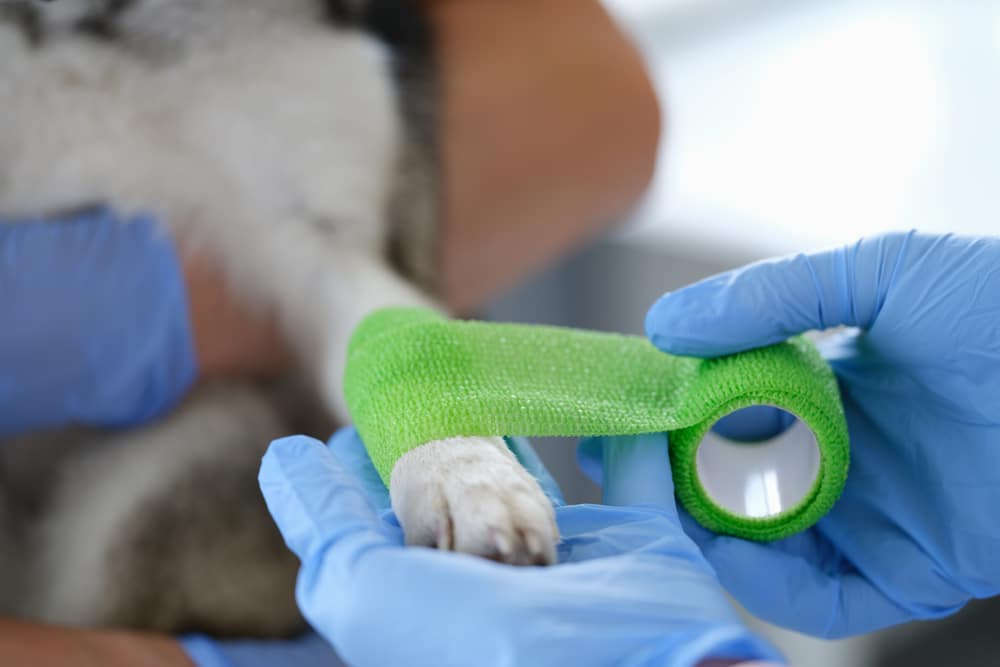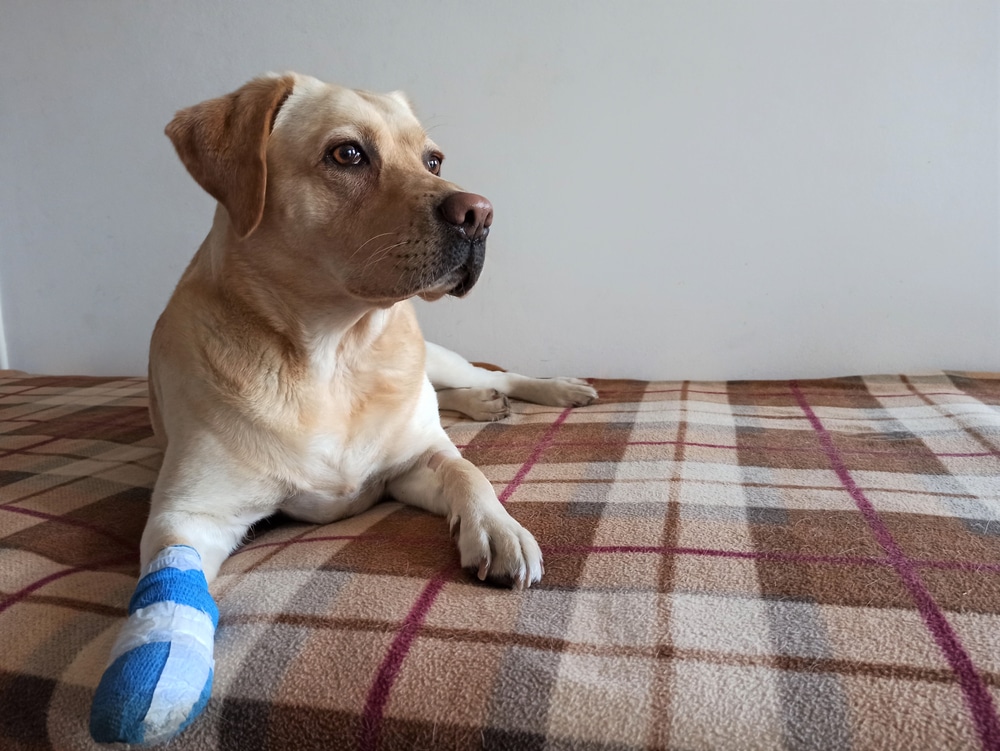Dogs are just like kids, ready for endless joy and playtime. But sometimes, they can play a bit too rough. Or they get into something they shouldn’t. Either way, they may end up bleeding, which can be a scary situation. So, what should you do if your dog is bleeding?
The first thing to do if your dog is bleeding is not to panic! Check where the bleeding is coming from, then apply some pressure or a tourniquet if possible (and while wearing gloves or using some other protective covering). Also, disinfect the wound with a dog-safe disinfectant and bandage it with a pet bandage. You may have to put a cone on your dog as well. If you don’t see that the bleeding is stopping, contact your vet or take your dog as soon as possible to the clinic.
Table of Contents
What To Do If Your Dog Is Bleeding

There are several steps to take in this case. The first is to figure out where the bleeding is coming from.
Try To Locate Where The Bleeding Is Coming From
Every pet parent gets scared when they see their fur baby bleeding. Sometimes, even small cuts or injuries can cause a bloody mess that could scare even a professional. Many times the bleeding is external, meaning it is coming from somewhere on the skin, the paw, or the ear. Those injuries can usually easily be managed and fixed with a little bit of help.
The scary type of bleeding is the internal kind. It is usually very hard for the owner to know that it is there, which potentially could end your dogs’ life because it can only be diagnosed by a vet. By the time the owner notices something is wrong with their pet, it is usually quite late. It will take a veterinary team’s skill and knowledge to find and fix the problem.
Try To Differentiate Between Arterial And Venous Bleeding
This is quite important to know because it can be the difference between life and death for your dog. Here are some common things to have in mind.
Arterial Bleeding
The color of the blood will be light red. The bleeding will be quite a lot too, as arterial blood is pumped with every beat of the heart. A dog with an arterial bleed could lose a lot of blood and die in a very short period if the bleeding can’t be stopped or managed with pressure or a tourniquet.
Venous Bleeding
The color of the blood would be darker. The bleeding will not be as fast as with an arterial bleed. When a dog is bleeding from a vein, it can be controlled easily by just putting some pressure over the spot that’s bleeding.
Stopping The Bleeding From Different Parts Of The Body
The most common places where dogs get hurt are the paws, the ears, or the torso. In this part, we will talk about what you could do at home in order to help your dog and stop the bleeding. Always remember to use gloves or some other protective barrier while stopping bleeding.
The Torso Or The Abdomen
The abdomen and the torso are tricky spots to have something that can give enough pressure to stop bleeding and yet not cause too much discomfort to the dog. The best way you can help your dog is by placing a towel or a clean cloth and then trying to use tape to put it into place. Remember that if the injury is to the torso, the tape should not be pulled too hard because it can become harder for your dog to breathe. If there are any funny sounds coming from the punctured place when the dog is breathing, make sure to rush to the emergency vet or to your local vet.
Paws And Legs
Dogs can get hurt on their paws and legs quite easily, either by walking in the bushes or between branches, or walking over glass. If you see a cut on your dog’s leg, you can use a towel to apply pressure directly over the cut and hold it like that for 5 to 10 minutes.
If your dog cuts its paw, then this will probably bleed even after it has stopped from the applied pressure. Do not worry, as this is normal. The pads on the dog have a web of small blood vessels that are being put on the ground constantly. You may need to come up with a way to keep the area away from direct contact with the surface and keep in mind that it will take some time for the cut to heal.
The Ear
Ear flaps are known to be hard bleeders but rest assured they don’t bleed enough for your dog to be in a life-threatening situation. If your dog has a cut on its ear, you can use either a clean towel or a cloth to put it on both sides of the ear and apply pressure.
Disinfect And Bandage The Wound
If you have pet-safe disinfectant and bandages, make sure to take both of these steps once the bleeding is stopped. This prevents infections and helps the dog recover. You may have to put a cone on your dog as well to stop it from ripping into the bandage as well.
Conclusion: What Should I Do If My Dog Is Bleeding?
Bleeding can be scary, but in most cases, it is something that is small and won’t require immediate veterinary attention as long as it is properly cared for. Vets are quite good at giving tips whenever a worried owner gives them a call for something like this, though. However, if you suspect your dog may have internal bleeding, do not waste your time on the phone, and take the dog to the nearest emergency hospital.
So, how are you going to prepare for the possibility of your dog bleeding? Let us know in the comments below!
